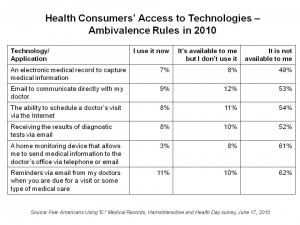While 8 in 10 Americans say that their physicians should have access to information contained in their electronic medical record, only 8% of people said an EMR is available to them but they don’t use it. Fully 37% of American adults are not sure their physicians even have an EMR, according to a HarrisInteractive/HealthDay survey on e-health records conducted in June 2010.
As the chart indicates, health consumers aren’t very engaged with other aspects of information applications that may be available to them, from scheduling a doctor’s visit over the Internet to accessing the results of lab trests via email.
As Humphrey Taylor, chairman of The Harris Poll, explained, “the general public only has a vague idea, only a very limited understanding, of what all this is about.”
Methodology: HarrisInteractive polled 2,035 U.S. adults in June 2010.
Health Populi’s Hot Points: “What all this is about,” as Humphrey Taylor puts it, is $20+ billion worth of ARRA HITECH incentives avaialble to physicians who adopt electronic health records. That’s taxpayer money, and the taxpayers don’t seem to get either the general concept of an EHR, nor their own physician’s possible use of them in practice.
Fewer than 1 in 10 Americans is using or accessing an electronic medical record, according to this survey. More health citizens in the Western region of the U.S. use EHRs the survey finds, which may be biased toward the early HIT adopters of Kaiser Permanente in California and Group Health Cooperative in Washington state. For those health citizens living in the rest-of-country, there’s a lack of exposure, experience, and appreciation for what an EHR is and what the benefits are that could accrue to their own, their families’, and their communities’ health.
Health direct-to-consumer ads have begun to come across mass media channels, most notably for prescription drugs. We’ve begun to see some consumer-facing promotions in media that highlight the existence and benefits of health information technology: two current examples are the GE Healthymagination program and Cisco’s telepresence ads (FYI, Matthew Holt of The Health Care Blog has an in-depth interview with Mike Barber of Healthymagination that’s worth a listen here).
This retail approach to marketing the benefits of health IT is part of what’s required for people to begin to visualize what EHRs are and what they can do. However, until people can translate that general market concept into the ‘what’s in it for me?,’ the Field of Dreams effect will prevail: President Obama may be funding EHR adoption, and GE/Dell/Allscripts et. al. may be marketing the systems, but Health Citizens won’t come along for the ride en masse. Without consumer health engagement, the ROIs on $20+ billion will be yet another sad story of wasted taxpayer dollars and lost health benefits.





 Thank you, Trey Rawles of @Optum, for including me on
Thank you, Trey Rawles of @Optum, for including me on  I was invited to be a Judge for the upcoming
I was invited to be a Judge for the upcoming  For the past 15 years,
For the past 15 years,